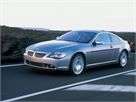Recent Articles
Popular Makes
Body Types
2004 BMW 6 Series First Drive

Ask BMW North America chief Tom Purves why BMW has encouraged the development of a risky design vocabulary that elicits love it or hate it response in the buying public, and he’ll reply, “No risk, no reward.” The way Purves and the man who penned the lines of the 2004 BMW 6-Series, Adrian von Hooydonk, see it, the well-heeled consumers likely to pay as much as $85,000 for the new 6-Series have probably taken risks of their own to achieve the level of financial success necessary to afford the latest in a storied line of BMW gran turismo coupes. They will understand the importance and rewards of risk.
Calling the 2004 BMW 6-Series “a car that you can drive fast and far,” von Hooydonk insists that modern luxury philosophies dictate conservative rather than flamboyant design, and yet automotive styling must generate excitement through expressive and emotional lines to attract and keep the interest of consumers who have increasingly short attention spans. Von Hooydonk’s theory goes that, given three-year development cycles and a minimum of seven years shelf life, designs must be cutting edge right out of the box. “You cannot be anonymous anymore,” he asserts, “even if your (anonymous) design is a good one.”
This latter statement, in BMW’s opinion, justifies its controversial design language of today and clearly articulates why the perfectly executed yet visually somnolent BMW designs of yesterday are history. Von Hooydonk says that BMW must chart its own course, a modern one, where no two of its products look alike. The 2004 BMW 6-Series is the latest of the German automaker’s automobiles to embody this philosophy in sheetmetal.
Truth be told, the hood is aluminum rather than metal, the front fenders are thermoplastic, and the bulging decklid covering a trunk large enough to hold two sets of golf clubs is sheet molded composite. Aiming to achieve a classic GT appearance, it was critical to get the long hood/short deck proportions of the new 6-Series just right. Also critical was the preservation of classic BMW design cues like the Hofmeister kink at the trailing edge of the rear side glass (named after a former head of BMW design), twin circular headlights, twin kidney grilles, distinct side character line and, on the company’s coupes and convertibles, the side marker light.
Page 2
Like most recent BMWs, the 2004 6-Series is more attractive in person than in photographs. We’re fans of neither the fishy face with its drooping headlights and downturned mouth nor the tall trunk that reminds us of a 1995 Dodge Stratus. Otherwise, this is a stunning automobile. Its long hood, low height, wide track, optional 19-inch wheels, and tasteful chrome accents exude elegance and strength, giving the 6-Series strong road presence and undeniable ‘six’ appeal.
Inside, a sumptuous cabin coddles four occupants in luxury and technology. We have but two complaints about the interior. First, the turn signal returns to center after engagement, a response by designers “to a question nobody asked” according to one BMW spokesperson. This action flies in the face of design convention, and is off-putting and sometimes confusing.
Second, and carrying greater impact, is BMW’s controversial iDrive. We understand that today’s luxury cars are technologically advanced showcases of engineering prowess, and that it makes complete sense to bundle infotainment operations into menus patterned after the familiar Microsoft Windows user interface. What we don’t understand is why primary and frequently used functions are buried within such an interface, unnecessarily distracting the driver from the task of driving. In BMWs, touted by the company’s advertising agency to be ultimate driving machines, it seems unfathomable that it is necessary to cycle through iDrive’s menus and constantly glance away from the road to view a display screen while simply tuning the radio.
Thomas Jefferson, launch manager for the 2004 6-Series, says that BMW North America has asked decision-makers at the company’s headquarters in Munich, Germany, for a simple array of stereo controls in the panel directly below the expertly executed climate control functions. The solution seems easy and in keeping with the desire to offer a minimalist appearance to the cabin, but Munich resists because European drivers have embraced iDrive.
BMW products that employ iDrive – the 5-Series, the 6-Series, and the 7-Series – have a wonderful selection of primary climate control knobs and buttons on the center of the dashboard. The driver can easily fiddle with the temperature, the mode, the fan speed and a number of other functions without touching the iDrive controller. Beneath this climate control panel is a CD player, buttons that cycle through the CD’s different tracks, and a knob that controls power and volume for the stereo. All other stereo functions must be accessed through obliquely marked steering wheel controls, oft-forgotten voice commands, or through the iDrive system. None of these solutions is as simple or as intuitive as a tuning knob and a row of radio station preset buttons.